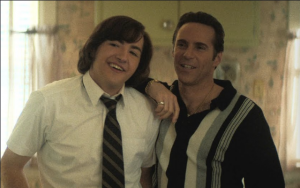CTV NEWSCHANNEL: MOVIE REVIEWS FOR SUNDAY JANUARY 20, 2024!
 I join CTV NewsChannel anchor Roger Peterson to have a look at the space thriller “I.S.S.,” the poignant “Memory” and the drama “Origin.”
I join CTV NewsChannel anchor Roger Peterson to have a look at the space thriller “I.S.S.,” the poignant “Memory” and the drama “Origin.”
Watch the whole thing HERE!
 I join CTV NewsChannel anchor Roger Peterson to have a look at the space thriller “I.S.S.,” the poignant “Memory” and the drama “Origin.”
I join CTV NewsChannel anchor Roger Peterson to have a look at the space thriller “I.S.S.,” the poignant “Memory” and the drama “Origin.”
Watch the whole thing HERE!
 I join “CTV News Toronto at Five” with host Natalie Johnson, to talk about the space thriller “I.S.S.,” the poignant “Memory” and the drama “Origin.”
I join “CTV News Toronto at Five” with host Natalie Johnson, to talk about the space thriller “I.S.S.,” the poignant “Memory” and the drama “Origin.”
Watch the whole thing HERE! (Starts at 13:06)
 I sit in with NewsTalk 1010 host Jim Richards on the coast-to-coast-to-coast late night “NewsTalk Tonight” to play the game “Did Richard Crouse Like This?” This week we talk about the space thriller “I.S.S.,” the poignant “Memory” and the drama “Origin.”
I sit in with NewsTalk 1010 host Jim Richards on the coast-to-coast-to-coast late night “NewsTalk Tonight” to play the game “Did Richard Crouse Like This?” This week we talk about the space thriller “I.S.S.,” the poignant “Memory” and the drama “Origin.”
Listen to the whole thing HERE!
 I join CP24 anchor Andrew Brennan to have a look at the space thriller “I.S.S.,” the poignant “Memory” and the drama “Origin.”
I join CP24 anchor Andrew Brennan to have a look at the space thriller “I.S.S.,” the poignant “Memory” and the drama “Origin.”
Watch the whole thing HERE!
 I sit in on the CFRA Ottawa morning show with host Bill Carroll to talk the new movies coming to theatres including the space thriller “I.S.S.,” the poignant “Memory” and the drama “Origin.”
I sit in on the CFRA Ottawa morning show with host Bill Carroll to talk the new movies coming to theatres including the space thriller “I.S.S.,” the poignant “Memory” and the drama “Origin.”
Listen to the whole thing HERE!
 Fast reviews for busy people! Watch as I review three movies in less time than it takes to pour a drink! Have a look as I race against the clock to tell you about the space thriller “I.S.S.,” the poignant “Memory” and the drama “Origin.”
Fast reviews for busy people! Watch as I review three movies in less time than it takes to pour a drink! Have a look as I race against the clock to tell you about the space thriller “I.S.S.,” the poignant “Memory” and the drama “Origin.”
Watch the whole thing HERE!
 Ambitious, audacious and just a little messy, “Origin,” the new film from director Ava DuVernay, now playing in theatres, is a study of the caste system told through the lens of a writer played by Aunjanue Ellis-Taylor. Part biography, part intellectual journey, it mixes the emotional with the academic.
Ambitious, audacious and just a little messy, “Origin,” the new film from director Ava DuVernay, now playing in theatres, is a study of the caste system told through the lens of a writer played by Aunjanue Ellis-Taylor. Part biography, part intellectual journey, it mixes the emotional with the academic.
Ellis-Taylor is bestselling author Isabel Wilkerson, who, in real life is the first woman of African-American heritage to win the Pulitzer Prize in journalism. Happily married to Brett (Jon Bernthal), she is considering taking some time off writing and lecturing to look after her aging and ailing mother.
But tragedy and her restless intellectual curiosity push her into exploring how the unspoken caste system has shaped America, and how people are still classified to this day by a pecking order of human classifications. To that end she travels the world and history, making stops in the American South, Berlin, and India to study which groups of people have power, and which do not.
Based on Wilkerson life and the writing of the book “Caste: The Origins of Our Discontents,” “Origin” is narrative film that feels stuck between two worlds. The blend of Wilkerson’s biography, mixed with dramatic re-creations of the historical events that feed into her research, is a mix of personal and the political, but it seems as if the film is trying to decide if it is a narrative or a documentary.
Still, the choppy presentation is chock full of thought-provoking ideas. DuVernay, who also wrote the script, crafts a unique movie about connectivity, one that isn’t afraid to swing for the fences. As the film skips through world history and Wilkerson’s life, a portrait of systemic subjugation eventually comes into focus, against a backdrop of personal loss. The film’s two prongs don’t feel like a natural fit, but Ellis-Taylor’s rock-solid performance anchors the film, providing a bridge between the emotional and intellectual.
“Origin” is an interesting movie, one that bristles with the spirit of discovery, but sometimes gets allows lucidity to get lost in its execution.
 Richard joins NewsTalk 1010 host Jim Richards on the coast-to-coast-to-coast late night “Showgram” to play the game “Did Richard Crouse like these movies?” This week we talk about to talk about the much anticipated “Sopranos” prequel “The Many Saints of Newark,” the latest adventures of the Gomez, Morticia and Company in the animated “The Addams Family 2” and the Jake Gyllenhaal thriller “The Guilty.”
Richard joins NewsTalk 1010 host Jim Richards on the coast-to-coast-to-coast late night “Showgram” to play the game “Did Richard Crouse like these movies?” This week we talk about to talk about the much anticipated “Sopranos” prequel “The Many Saints of Newark,” the latest adventures of the Gomez, Morticia and Company in the animated “The Addams Family 2” and the Jake Gyllenhaal thriller “The Guilty.”
Listen to the whole thing HERE!
 “The Many Saints of Newark,” the sprawling big-screen prequel to the iconic television series “The Sopranos,” feels more like a pilot for a new show than the origin story of one of television’s most famous families.
“The Many Saints of Newark,” the sprawling big-screen prequel to the iconic television series “The Sopranos,” feels more like a pilot for a new show than the origin story of one of television’s most famous families.
Broken into three parts, “The Many Saints of Newark,” uses narration, courtesy of Tony Soprano’s late associate Christopher Moltisanti (Michael Imperioli), to break down the movie’s interconnected story shards.
Firstly, there is Dickie Moltisanti (Alessandro Nivola), Soprano Family soldier, father of Christopher, cousin to Carmela Soprano, uncle to Tony. He’s hooked up, wily and impulsive but also treacherous. When his father, the slick sociopath ‘Hollywood Dick’ (Ray Liotta), returns from Italy with a new bride (Michela De Rossi), it triggers chaos in the Moltisanti family.
In Dickie’s orbit is Harold McBrayer (Leslie Odom Jr.), an African-American numbers runner for the Mob, galvanized by the 1967 Newark race riots to go out on his own and, finally, Tony Soprano, played by William Ludwig as a youngster, Michael Gandolfini, the late James Gandolfini’s son, as a teenager. As Dickie’s thirst for power spins out of control, he becomes a surrogate father to Tony, hoping to pass along something good to the impressionable younger man as a way to atone for his sins.
“The Many Saints of Newark” is vivid in its portrayal of the period. Covering roughly four years, from 1967 to 1971, it uses the turmoil of that time in American life as a backdrop for the explosive nature of Dickie’s world. That atmosphere of uncertainty makes up for a story that, despite some glorious moments, often feels rushed as it careens toward an ending that doesn’t mine the rich psychological landscape of these characters, which is what we expect from David Chase and “The Sopranos.”
The actors are game.
Nivola brings equal parts charisma, danger and depth to a flawed character who is the ringmaster to the action. Unlike many of the other characters, like the conniving Junior Soprano (Corey Stoll), henchman Paulie Walnuts (Blly Magnussen) or consigliere Silvio Dante (John Magaro), who come with eighty-six episodes of baggage, Dickie is new and can be viewed through fresh eyes.
Michael Gandolfini takes on the Herculean task of revisiting a character his father made one of the most famous in television history and brings it home by showcasing the character’s volatility and, more importantly, his vulnerability. He’s a troubled kid, on the edge of turning one way or the other, and even though we know how the story goes, Gandolfini’s performance suggests there is more to know about Tony Soprano.
If there is a complaint, it’s that both Tony and McBrayer, two of the main cogs that keep this engine running, get lost in “The Many Saints of Newark’s” elaborate plotting. Ditto for the female characters. Despite tremendous work from Vera Farmiga as Tony’s poisonous mother Livia and De Rossi as Dickie’s step-mom, the women often feel peripheral to the tale, in service only to the men’s stories.
“The Many Saints of Newark” brings with it high expectations but falls short of coming close to the greatness of its source material. “The Sopranos” broke new ground, changing the way gangster stories (and all sorts of other stories) were told on television. “The Many Saints of Newark” settles for less as an exercise in nostalgia.